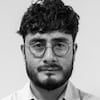Crisis in Mexico’s Federal Electoral Tribunal: The slow-motion fall of a judge
EL PAÍS has reconstructed the battle to control the institution that will oversee the upcoming presidential elections in Mexico. This report examines the role of the magistrates, the political power they wield, as well as the slow-motion fall of Judge Reyes Rodríguez, the head of the court who was forced to resign
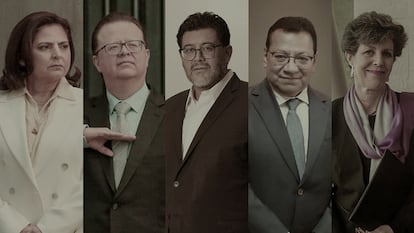
The Federal Electoral Tribunal (TEPJF, its acronym in Spanish) — the body within the judiciary of Mexico that specializes in electoral matters — went through its worst institutional crisis a few weeks ago. A group of three judges — out of a plenary session made up of five — pressured its president, Judge Reyes Rodríguez, to resign early from office, 10 months before the formal end of his term. In his place, the majority bloc appointed Judge Mónica Soto.
On the horizon of this maneuver are the general elections, scheduled for June 2. President Andrés Manuel López Obrador’s political project is seeking continuity in power. The TEPJF is the highest authority on electoral matters and is in charge of deciding whether an election is clean and if the results are valid. The Electoral Tribunal has the jurisdiction to annul a victory.
Control of the institution means a lot in political terms. The internal struggle began due to differences between the magistrates themselves, particularly between Rodríguez and Felipe de la Mata, head of the opposition group. However, as time went by, external political actors joined the struggle, which accelerated Rodríguez’s fall from the presidency of the court.
Through a dozen sources, EL PAÍS has reconstructed a crisis that has been brewing since the middle of last year, which finally exploded in December. This newspaper spoke with the five magistrates separately, during the first and second weeks of January. All except for Judge Soto — the new president of the Electoral Tribunal, who has called to move on from the episode — offered their own version of the conflict, on the condition that they not be recorded or quoted.
Everyone was aware that the voices of their counterparts would be collected for this chronicle. Individuals from all the magistrates’ offices were also consulted, as were witnesses to meetings. The conversations allowed dates, meetings and topics of discussion to be corroborated and contrasted. This helped to recreate the negotiations, the betrayals… and the occasional screaming.
In the conversations, names of electoral lobbyists, judges and party leaders — who intervened in one direction or another in the conflict — came to light. They emerged either to overthrow Rodríguez, or to prevent his fall. Salvador Nava — the lawyer for Claudia Sheinbaum, the presidential candidate for the ruling party — has been referred to as one of the actors who exerted pressure from outside the court. Santiago Creel — campaign coordinator of Xóchitl Gálvez, the opposition coalition candidate — also intervened in the negotiations. Roberto Gil — a former senator and a powerful lawyer from the PAN, the largest conservative party in Mexico — was also summoned. Minister Norma Piña — president of the Supreme Court — tried to mediate during the rebellion against Rodríguez… but the judge still ended up stepping aside.

Instability has marked the history of the TEPJF. The institution — which boasts of being independent and stable — has proven to be very fragile in the face of external political influences. Since the current justices were appointed by the Senate in 2016, the Electoral Tribunal has had five presidents, with none of them having been able to complete their four-year-long term. Experts maintain that the interference of outside actors is serious, especially in a key electoral year, when the presidency of Mexico, the two chambers of Congress, nine governorships and thousands of state-level posts are being contested. Added to this porosity is the fact that the bench has been incomplete (there should be seven judges, not just five), since the Senate — dominated by MORENA, the president’s party — hasn’t elected replacements for the judges who left in October.
Former electoral councilor Alfredo Figueroa feels that this is the worst crisis that the institution has gone through. “The role that the Tribunal will have in the coming months in the life and stability of the country is absolutely important… we shouldn’t toy with the notion that this institution could simply end up becoming a decorative element of public life. That’s why this crisis is so serious and so important. The court has a connection with legitimacy, but also with the governability of the country. It draws a lot of attention, [which I believe] comes from sources of power. What else is the purpose of intervening — with this degree of destruction — in institutions such as the [National Electoral Institute] and the Tribunal? It hits directly at the heart of a legal and legitimate election,” he says, in an interview with EL PAÍS.
The loneliness of the head judge
Rodríguez was a president who was left alone inside and outside the institution he directed (his only internal ally has been Judge Janine Otálora, with whom he now forms the minority bloc). Internally, Rodríguez imposed a policy of austerity in spending that bothered his counterparts, according to the testimonies collected. Judges Felipe De la Mata, Felipe Fuentes and Mónica Soto — who make up the majority bloc — also feel that he led the court on his own, without taking them into account in the decisions made.
Since August of 2023, the magistrate had heard that three of his colleagues had begun to talk about the possibility of removing him from the presidency. He actually learned of this conversation from one of them, who — at that time — assured him they wouldn’t participate in such a revolt. As the weeks went by, the rumor was seasoned with two additional elements, which, for Rodríguez, were worrying: one, that the government had supposedly decided that he wouldn’t be the one to hand over the presidential certification to Sheinbaum (alreday taking for granted her triumph at the polls). And two, that neither MORENA — the ruling party — nor the candidate trusted him. On the contrary, they believed that he had the intention of obstructing their path to power. The versions had credibility for the magistrate, since President López Obrador himself has expressed — on several occasions — his distrust of Rodríguez, whom he identified with former president Felipe Calderón’s (2006-2012) of the PAN, one of the president’s worst enemies.
Rodríguez approached two important officials in the Supreme Court of Justice. On August 21, for the first time, he informed Minister Piña that a rebellion was brewing in the TEPJF to overthrow him from the presidency. The magistrate also looked for an ally in Minister Arturo Zaldívar. In 2021 — as president of the Supreme Court — Zaldívar had to deal with another institutional crisis, when a majority of justices deposed its then-president, José Luis Vargas. At that time, Zaldívar facilitated the transition of power to Rodríguez.
This time around, Zaldívar — before resigning from the Supreme Court to join Sheinbaum’s campaign — met with De la Mata, Fuentes and Soto. At the meeting — confirmed by one of the participants — the group made him aware of the reasons for the disagreement with Rodríguez, mostly related to the internal administration of the TEPJF. The minister advised them not to continue down the path of removing him from the presidency, given the proximity of the elections. He also suggested to Judge Rodríguez that he give in to the demands of the majority bloc to calm the waters. But then, Zaldívar disappeared from the scene, while President Piña waited all the way until December to intervene in the conflict.
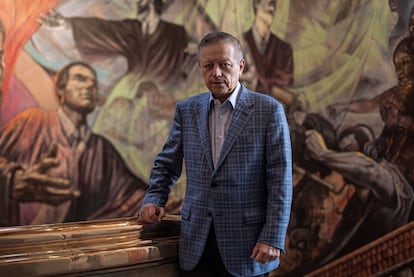
The crisis continued and worsened. Through an intermediary, Rodríguez asked Sheinbaum if the rumors that she didn’t trust him were true. He also suggested that they sit down and talk to clear away the doubts. The intermediary did the work and responded the same day that the candidate had no problem with him. The magistrate also made consultations — again, via intermediaries — to the Ministry of the Interior and the National Palace. Senior officials from both institutions responded in the same way: the maneuvering wasn’t the work of the government.
EL PAÍS has consulted two members of Sheinbaum’s inner-circle about the candidate’s role in the conflict. They have assured this newspaper that the former head of the Government of Mexico City had engaged in no interference. They also noted that the people who used her name to justify the removal of Rodríguez from the presidency did this without her knowledge or authorization.
Speaking into the recorder, Rodríguez affirms that one of the figures who backed up the rumor from Sheinbaum’s group was Salvador Nava, a former TEPJF magistrate and, today, the legal representative for MORENA’s presidential candidate. Rodríguez confronted him on October 3, 2023. “[People] told me that, on Claudia’s team, he was saying that they couldn’t get along with me and that I wanted to screw them. He denied [this] and told me that those who spoke badly about me were Mario Delgado (the leader of MORENA) and the party’s head of legal matters, Euripides Flores. He told me that they complained that I had meetings with businessmen, with the media and some journalists, such as Leo Zuckerman (a critic of the government),” the magistrate recalls.
Nava has rejected Rodríguez’s accusation. “I told him that it was false, that I have no interest in harming him, that I’ve never told anyone on the team that he has something against Dr. [Sheinbaum] or MORENA. In fact, during the meetings at work, jurisdictional issues are never discussed, there’s nothing political there,” the lawyer claims. He also denies having mentioned the party leaders.
Salvador Nava has had an important role in the Tribunal as a litigator on electoral matters following his departure from the institution in 2016. In his dual capacity — as a former magistrate and electoral lawyer, in addition to being a friend of De la Mata — Nava has long had the doors of the TEPJF wide open to him. For instance, in the second week of October,
De la Mata and Fuentes traveled to Havana to give conferences on democracy. Nava also attended the trip, invited by the Electoral Judicial School of the Federal Electoral Tribunal… a body directed by Judge De la Mata. And then, following the internal revolt, Nava was present at Soto’s first session as the new president of the Tribunal, on January 1.
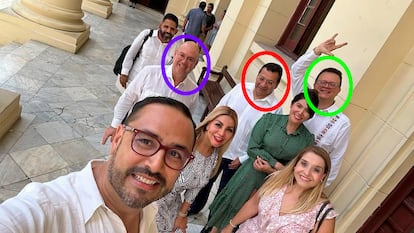
Rodríguez was distanced from the leaders of all three major federal parties. Representatives of MORENA, the PRI and the PAN tried to approach him to ask him to vote in a certain way on issues that interested them, according to the magistrate’s staffers. An orthodox judge, Rodríguez didn’t agree to listen to the offers made by political leaders and government officials. Hence, given his closed-door attitude, when he sought help to stop his removal from the presidency, the party leaders let him fall. Mario Delgado even publicly celebrated his resignation.
Only Dante Delgado — leader of the Citizens’ Movement (MC) — advocated in his favor. The first week of December, the party leader called one of the magistrates of the rebel bloc and told him that it wasn’t a good time to change the head of the Tribunal, just five months before the election. EL PAÍS tried to speak with Delgado about his role in the conflict, but the politician didn’t respond to the request for comment. Two judges from the majority group have confirmed that the MC leader made the call.
On December 8, the coordinator of Xóchitl Gálvez’s presidential campaign — Santiago Creel — sought out Rodríguez… but not to help him remain in office. Rather, he wanted to propose a smooth path towards his resignation, according to the magistrate. Rodríguez tells this newspaper that the PAN operative told him about a plan agreed between Marko Cortés — president of the PAN — and Judge De la Mata. The plan was for Rodríguez to leave the presidency and that Janine Otálora — in her capacity as senior magistrate — would temporarily take his place. A new president would then be elected from among Soto, De la Mata and Fuentes. According to the magistrate, Creel offered that the agreements be signed and that there be an honorary witness to serve as guarantor. It seemed like a viable proposal to Rodríguez, but it didn’t go through because — as he claims — De la Mata didn’t discuss it with his bloc, while Soto firmly rejected it.
Creel acknowledges that he spoke with De la Mata and Rodríguez to ask them to reach an agreement, but that his actions were never for or against anyone. He claims to have done it in a personal capacity, as a defender of public institutions. “I told them to preserve the Tribunal, to privilege institutional interests over group or personal interests,” he affirmed in an interview. “I asked them — before this situation further weakened the Tribunal — to reach a consensual agreement, to make it last, to not continue beheading the institution, to maintain unity to face the most important election of this century. I told them that, for me, what’s at stake are the institutions and that an internal conflict offers the foundation for external actors — with political interests — to intervene, because they see a weak institution.”
EL PAÍS asked Xóchitl Gálvez — through her spokesperson — if she was ever aware of her campaign manager getting involved in the court. The candidate of the opposition coalition — made up of the PAN, PRI and PRD — flatly replied that she had no knowledge of this.
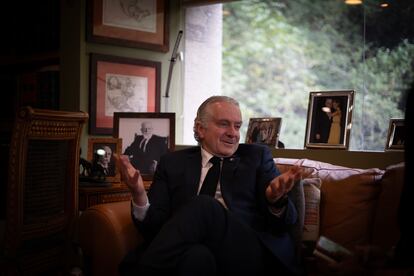
Dinner with Roberto Gil
On August 8, there was a dinner between Judge De la Mata and former PAN senator Roberto Gil in the latter’s law office. The meeting was confirmed by two participants. The figure of Gil in this story is relevant for several reasons. He was president of the Congressional Justice Commission that processed the appointment of the current TEPJF magistrates, back in 2016. He was president of the Senate and negotiated the controversial extension of the electoral judges’ terms. He was also the private secretary of former President Felipe Calderón — with whom he has a very close relationship — and continues to exert influence in the PAN through some senators.
Reyes Rodríguez worked with Gil in the Senate, before being appointed regional magistrate in 2013, from where he jumped to the TEPJF three years later. From De la Mata’s standpoint, Gil is Rodríguez’s godfather and protector.
There are two different versions of what happened at that dinner. One comes from the magistrates’ environment. This story indicates that Gil proposed to De la Mata that a majority bloc be formed in the TEPJF between him, Rodríguez and Otálora, in view of the upcoming departure of two judges from the court in October, who were concluding their duties. There would be a plenary session of five judges and a new majority would have to be formed to govern the institution, without Fuentes or Soto. De la Mata’s entourage maintains that Gil wanted the new bloc to negotiate rulings with the candidates running in the 2024 election.
No evidence was provided for this accusation.
At the dinner, De la Mata didn’t respond to the former senator’s alleged proposal. He told him that he was going to think about it. Shortly afterwards, he explains that Gil and Rodríguez began to pressure him to join the bloc. To do this — according to the same sources — they turned to a lawyer, a former colleague of De la Mata, with whom the magistrate has a conflict. First, Gil met with the lawyer, who was attempting to become a regional magistrate through a Senate appointment. After this meeting, Rodríguez hired her, so that — according to him — she wouldn’t be left without a job. For De la Mata, it was clear that agreeing to Gil’s proposal would be by hook or by crook. These signals distanced De la Mata from Rodríguez and Otálora, bringing him closer to Fuentes and Soto.
Gil rejects this version of events. The former senator assures EL PAÍS that, in the meeting — which was allegedly requested by De la Mata through an intermediary — the magistrate flaunted his ability to communicate with politicians and members of the Supreme Court, which had allowed him to place people who were close to him on the shortlists of candidate for regional magistrate positions (which the Senate was analyzing at the time). “He was very proud of that operating capacity. And that’s how he expressed it to me: that he was spearheading policy work that no one else on the Tribunal was doing so successfully, not even Reyes Rodríguez. I told him that internal solutions had to be found so that the Tribunal could enter the electoral process [from a place of strength and legitimacy]. I didn’t mention any strategy of creating groups or majorities, [nor did I speak] about isolating anyone,” Gil states.
The PAN politician maintains that De la Mata asked him for help to veto some candidates from the shortlists… including the former colleague who he had clashed with. “That was the reason why he asked me for the meeting. He wanted help boosting some profiles and he explicitly asked me for help vetoing [the appointment of] others, including that lawyer.” The former senator claims that he didn’t agree to this lobbying request.
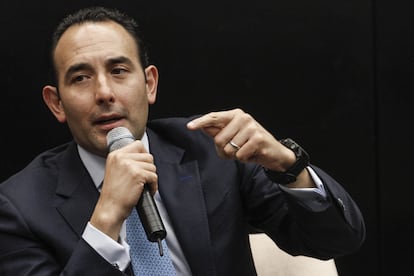
Gil adds that De la Mata also asked him to convince Rodríguez to resign as president of the TEPJF. “He suggested that I ask him to resign so that De la Mata could assume the presidency, because the only one who could provide stability and dialogue was him, due to his good relationships within the Tribunal [and his ability to] dialogue with all the political actors. The proof of his success was in the shortlists for magistrates. I replied that I didn’t know that the purpose of the meeting was to create coups d’état. I didn’t even accept the suggestion… I wasn’t going to be, in any way, a spokesperson for that type of thing,” he insists.
The PAN member acknowledges that he did receive De la Mata’s former colleague, as well as other aspiring magistrates who sought him out, he claims, to ask for advice. He says that he didn’t talk about De la Mata with the lawyer. Gil maintains that the Senate confirmed that the PAN leadership ordered the veto of the lawyer’s appointment, as the judge supposedly requested. This assertion couldn’t be confirmed. However, what’s clear is that the shortlist ultimately ended up being discarded, because no candidate gathered the necessary votes. Judge De la Mata was asked — through his spokesperson — if he wanted to respond to Gil’s accusations on the record. He declined.
The tragic dozen
The climax of the crisis occurred in the first two weeks of December. On Monday the 4th, De la Mata, Fuentes and Soto were deliberately absent from Rodríguez’s annual report, which he had to deliver in his capacity as president of the TEPJF. And, by Friday the 15th, Soto’s promotion was completed. That dozen days were the worst that Rodríguez faced amidst the months-long rebellion that demanded his head.
At dawn on Wednesday, December 6, Judge Felipe Fuentes received messages via WhatsApp from the president of the Supreme Court, Minister Piña, whom he has known for years (they met at a circuit court in Mexico City). A judge from the majority bloc affirms that the judge wrote that she didn’t agree with what Fuentes, De la Mata and Soto were doing — she asked them to stop. The minister used phrasing that the group considered threatening, according to the same source. Far from giving in, the magistrates accused Piña of undue pressure and interference in the autonomy of the TEPJF. The judges envisioned a scenario of a high-profile institutional clash between the two constitutional courts.
Judge Fuentes didn’t show the messages to Rodríguez or Otálora, but he told them that he had them. The magistrate didn’t want to show them to this newspaper, either. A spokesperson for Piña has confirmed that the minister’s messages exist, but assures this newspaper that they’re not threatening. To heal the differences between them, Piña invited Fuentes, De la Mata and Soto to dinner two days later. With that dinner, the minister’s mediation in the conflict concluded.
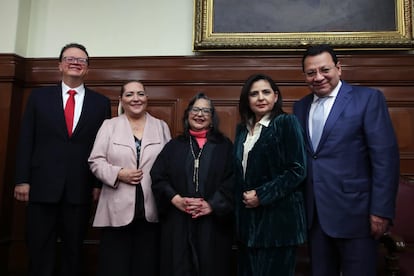
On Wednesday, December 6, there was a three-hour-long meeting between the five judges at the Electoral Tribunal. A public session had been scheduled, but it was ultimately postponed to the next day. The majority bloc told Rodríguez that his resignation from the presidency couldn’t be postponed due to “loss of confidence” in his leadership. They were incensed that Rodríguez branded them as corrupt outside the courthouse, while Roberto Gil — “his boss” — engaged in lobbying and did business deals while taking advantage of the magistrate’s position. The bloc of three also reproached him for having sought out actors outside the TEPJF to intercede on his behalf. Rodríguez then brought up De la Mata’s meeting with Gil and explained that the magistrate had asked that he be put in the presidency, not Soto. De la Mata denied that he had made such a request.
Then came the screaming. Rodríguez — still the president — asked his colleagues for time to make a decision. He even suggested that he might not only resign from the presidency, but from his position as an election judge entirely. Otálora said that she was considering the same path. The departure of the two judges would have led to a sudden paralysis of the TEPJF. However, this scenario didn’t occur in the end.
They left the meeting without reaching an agreement. That Wednesday night, Judge Soto had dinner with Sergio Gutiérrez Luna, a legislator and MORENA’s main operator in electoral matters. A photo of the meeting was leaked to the media and raised suspicions about the interests at play behind the crisis. The next day — Thursday, December 7 — the postponed session was held. And there, before the public, Fuentes asked to include Rodríguez’s resignation from the presidency on the agenda. De la Mata mentioned that there was “a strange [involvement] of law firms in the life of the court,” in reference to Gil. Rodríguez offered to give them his answer on Monday.
On Saturday, December 9, Rodríguez met with Creel, who made him the transition offer agreed upon between the PAN leader, Cortés and Judge De la Mata. On Monday the 11th — in the decisive meeting with his colleagues — Rodríguez said that he had thought about this proposal and that he agreed. Soto was surprised. According to one of the magistrates, Soto had already agreed with her bloc that she would hold the presidency. The proposal from De la Mata and the PAN implied an election between the three that didn’t guarantee her the position. It was clear that this plan hadn’t been discussed among the majority group and that De la Mata had a parallel agenda. Soto quickly expressed her rejection and demanded that the transition period be accelerated.
On December 15, Soto was finally elected president of the Electoral Tribunal in a private session. De la Mata and Fuentes voted for her, while Rodríguez and Otálora voted against her. According to the Organic Law of the Judiciary, Soto is permitted to remain in office for the remainder of Rodríguez’s term… that is, until October of this year. But the magistrate shielded herself. In the agreement published by the Mexico Federal Official Gazette, it was established that she remain as president of the Tribunal until she finishes her own term as a judge at the TEPJF, in October of 2025. Distrust — even among allies — continues to haunt the corridors of justice.
Sign up for our weekly newsletter to get more English-language news coverage from EL PAÍS USA Edition
Tu suscripción se está usando en otro dispositivo
¿Quieres añadir otro usuario a tu suscripción?
Si continúas leyendo en este dispositivo, no se podrá leer en el otro.
FlechaTu suscripción se está usando en otro dispositivo y solo puedes acceder a EL PAÍS desde un dispositivo a la vez.
Si quieres compartir tu cuenta, cambia tu suscripción a la modalidad Premium, así podrás añadir otro usuario. Cada uno accederá con su propia cuenta de email, lo que os permitirá personalizar vuestra experiencia en EL PAÍS.
¿Tienes una suscripción de empresa? Accede aquí para contratar más cuentas.
En el caso de no saber quién está usando tu cuenta, te recomendamos cambiar tu contraseña aquí.
Si decides continuar compartiendo tu cuenta, este mensaje se mostrará en tu dispositivo y en el de la otra persona que está usando tu cuenta de forma indefinida, afectando a tu experiencia de lectura. Puedes consultar aquí los términos y condiciones de la suscripción digital.
More information
Archived In
Últimas noticias
Most viewed
- Sinaloa Cartel war is taking its toll on Los Chapitos
- Oona Chaplin: ‘I told James Cameron that I was living in a treehouse and starting a permaculture project with a friend’
- Reinhard Genzel, Nobel laureate in physics: ‘One-minute videos will never give you the truth’
- Why the price of coffee has skyrocketed: from Brazilian plantations to specialty coffee houses
- Silver prices are going crazy: This is what’s fueling the rally
